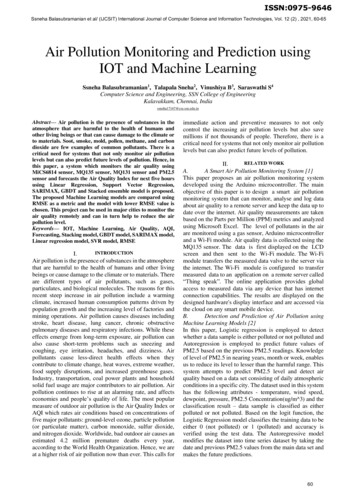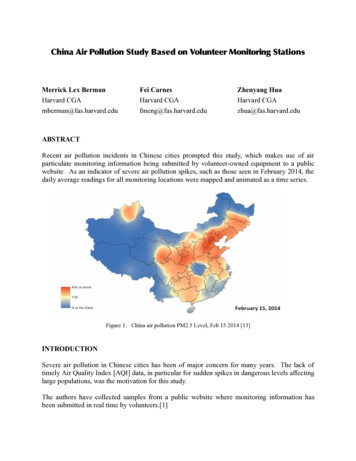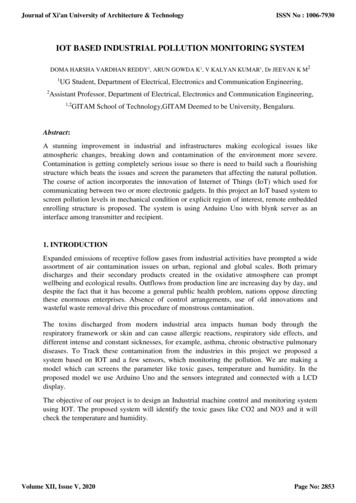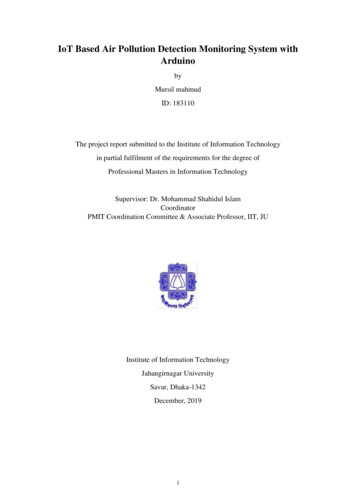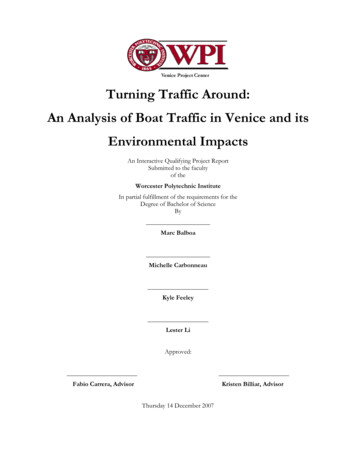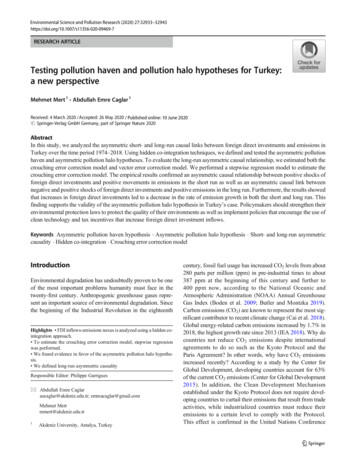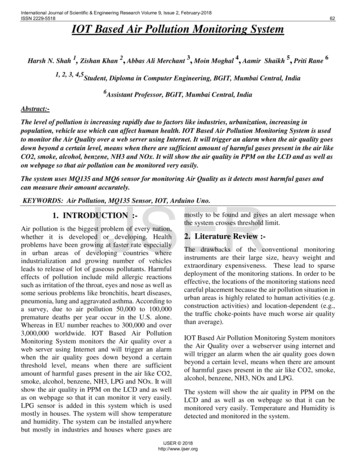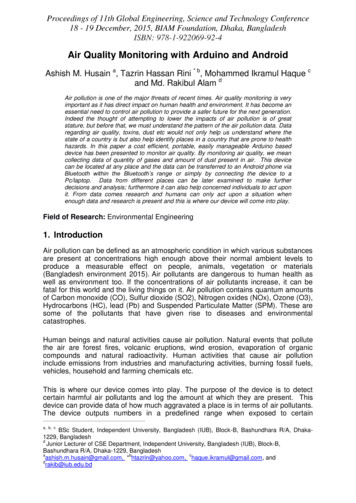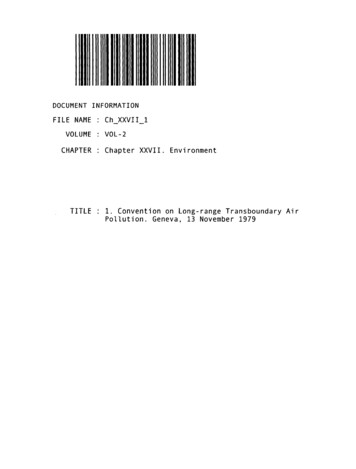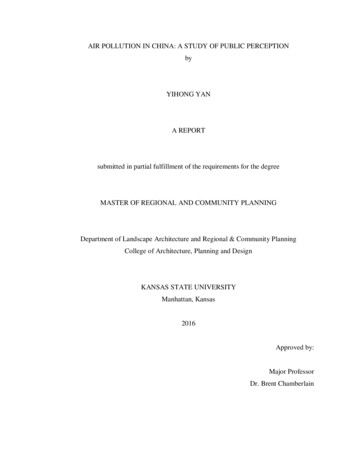
Transcription
AIR POLLUTION IN CHINA: A STUDY OF PUBLIC PERCEPTIONbyYIHONG YANA REPORTsubmitted in partial fulfillment of the requirements for the degreeMASTER OF REGIONAL AND COMMUNITY PLANNINGDepartment of Landscape Architecture and Regional & Community PlanningCollege of Architecture, Planning and DesignKANSAS STATE UNIVERSITYManhattan, Kansas2016Approved by:Major ProfessorDr. Brent Chamberlain
CopyrightYIHONG YAN2016
AbstractAir pollution is a serious health and environmental problem. In fact, poor air quality has beenlinked to numerous diseases and is a significant public health issue related to urban planning.These problems can be clearly seen in urban Chinese cities, most recently with the first ever RedAlert in Beijing China in 2015. In 2015, director Chai Jing developed a documentary depictingthe bad effects on health of air pollution in China. However, soon after the release of the film, itwas banned. One important finding in the film was the misperception the Chinese people hadabout the kinds of pollution and the health impacts. Therefore, this study aims to investigate theextent to which Chinese people understand the causes of air pollution and their related healtheffects. Accordingly, a survey was produced and delivered via Chinese social medium. Thesurvey had three objectives: study the perception of 1) Air quality and the source of air pollution,2) Health effects if air pollution, and 3) Air pollution and Environmental policies. The resultsshow that 44% Chinese people feel air quality is worse now than a year before, and 72% peoplefeel air pollution has affected their health. One main finding in this study was that youngerpeople took the survey more than older people, as perhaps because they may have started to havea family or become a family; this is significant because air pollution is harmful for children. Theother main finding was that 52% people did not know a China Air Pollution and Prevention Lawexists.
Table of ContentsTable of Contents . ivList of Figures . viList of Tables . viiiAcknowledgements . ixDedication.x1Introduction.11.11.1.12Air Pollution in China .2Public Awareness of Air Pollution .41.2Research Question and Project Objectives .51.3Study Context and Area .61.3.1Tianjin Warehouse Explosion .71.3.2China’s Red Alert for Air Pollution .81.3.3The United States and China Co-operate on Climate Change . 111.3.4Study Site . 12Methodology . 152.1Survey. 162.1.1Demographics and Background . 182.1.2Air Quality and Source of Pollution . 192.1.3Health Effects of Air Pollution . 222.1.4Air Pollution and Environmental Policies . 232.2Distribution of Survey through Social Media . 262.2.1WeChat . 262.2.2Weibo . 282.2.3QQ . 312.3Analysis Techniques . 322.3.1Exclusion Criteria for Data . 322.3.2Descriptive Statistics . 332.3.3Regression Model. 332.3.4Spatial Map . 33iv
3Results . 353.1Demographics and Background . 353.2Air Quality and Source of Air Pollution . 413.2.1Air Quality and Source of Air Pollution . 423.2.2Activities That Affect Air Pollution . 433.2.3Traffic-Related Circumstances that Affect Air Pollution . 453.33.3.1Pulic Health and Air Quality . 503.3.2Air Pollution and Public Health . 513.4Air Pollution and Environmental Policies . 533.4.1Activities to Reduce Air Pollution . 533.4.2Innovative Transportation Policies. 563.54Health Effects of Air Pollution . 49Regional Comparison Results . 583.5.1Different Region Rated Air Quality . 583.5.2Differences of Opinion About Transportation Policies . 60Discussion and Conclusion . 634.1Discussion . 634.1.1Limitations . 644.1.2Results Analysis . 654.1.3Contrast with Other Research . 684.1.4Policy Recommendations to Improve Current Conditions . 694.2Conclusion . 72References . 74Appendix A -Surveys . 86Appendix B – Figures and Tables . 103v
List of FiguresFigure 1.1: During Air Pollution and After Air Pollution in Downtown Beijing in 2013 .4Figure 1.2: After Chemical Explosion in Tianjin .7Figure 1.3: The Distance between Explosion Place and Residential Area .8Figure 1.4: Beijing in Pollution and On Blue Sky Day .9Figure 1.5: Air Pollution in Shi Jiazhuang, Heibei Province . 10Figure 1.6:Air Pollution in Hohot, Inner Mongolia on November 29 . 10Figure 1.7: China Air Pollution Forecast for December 19-23, 2015. 10Figure 1.8: Chinese People Wearing Masks to Travel in Beijing . 11Figure 1.9: Map of China . 13Figure 1.10: The Location of Jing-Jin-Ji . 14Figure 2.1: Flow Chart of Research Design . 15Figure 2.2: WeChat App logo . 27Figure 2.3: Sending the Link to Someone Individually . 27Figure 2.4: Someone Sending the Link to A Group Chat . 27Figure 2.5: The Researcher Sending the Link to A Group Chat . 28Figure 2.6: The Researcher Sending the Link to Someone Individually . 28Figure 2.7: Weibo Logo . 29Figure 2.8: Someone Likes the Reply Post . 29Figure 2.9:Someone Replies to the Post and Gives Their Opinions . 29Figure 2.10: How to Search the Topic in Weibo . 30Figure 2.11: Search for “Beijing Air Pollution” . 30Figure 2.12: Search for “Air Pollution” . 30Figure 2.13: The QQ Logo and Frame . 31Figure 2.14: Researcher Sent Post to Someone On Contact List in QQ . 32Figure 3.1: Survey Sample Population Pyramid . 36Figure 3.2: 2014 China’s Total Population Pyramid . 36Figure 3.3: Spatial Map of the Survey Responses . 37Figure 3.4: Education Pie Chart . 38Figure 3.5: Employment Status Pie Chart . 39vi
Figure 3.6: Employer Type . 40Figure 3.7: Area of Expertise, Occupation and Discipline. 40Figure 3.8: Income Distribution. 41Figure 3.9: Rated Air Quality . 43Figure 3.10: Perception of where Air Pollution Originates as Distribution . 43Figure 3.11: Activities’ Influence on Air Pollution . 45Figure 3.12: Motor Vehicles as Source of Air Pollution. 47Figure 3.13: Number of Cars in Per Household . 48Figure 3.14: Annual Vehicle Ownership per 1000 in China (2012-2050) . 48Figure 3.15: Transportation Mode to Go to Work . 49Figure 3.16: Air Pollution and Public Health . 50Figure 3.17: Percentage Rating of Effect of Air Pollution on Public Health . 52Figure 3.18: Identify in What Ways You Were Affected . 53Figure 3.19: Options to Reduce Air Pollution . 55Figure 3.20: China Air Pollution and Prevention Control Law . 56Figure 3.21: Acknowledge Whether You Agree or Disagree with the Lottery for Buying Cars . 57Figure 3.22: Tag Control Number Showing Policy Agreement and Disagreement . 58Figure 3.23: Rated Air Quality in Four Regions . 59Figure 3.24: Respondents Lottery for Buying Cars in Four Regions . 61Figure 3.25: Tag Control Number in Four Regions . 62Figure B.4.1: Report Violation . 103Figure B.4.2: Develop Economy Statement . 103vii
List of TablesTable 3.1: The Number of Cars and Traffic Jams . 49Table 3.2: The Number of Cars and Drive Alone . 49Table 3.3: The Relationship Between Air Quality and Health . 51Table 3.4: Explanation of Figure 3.19 . 55Table 3.5: The Relationship Between China Air Act and Laws and Policies for EnvironmentalManagement . 56Table 3.6: The Relationship Between Education and China Air Act . 56Table B.1: The Source of Air Pollution . 104Table B.2: Motor Vehicles as Source of Air Pollution . 105Table B.3: Transportation Mode . 106viii
AcknowledgementsI would like to thank my major professor, Dr. Brent Chamberlain, for his patience and guidance.Without his help, I could not have narrowed down my broad topic, and I want specifically tothank him for his patience in helping me improve my English while finishing the report.I also would like to thank the other members of my committee, Dr. Huston Gibson, and Dr. HuanLiu, who comes from Tsinghua University, Beijing, China, for giving me suggestions andcritiques of this project.I also would thank to my friends and my peers. During these seven years study abroad, they havegiven me much support and encouragement. Specifically, I would like to thank my friendsBingyi Li and Bing Han. They are both best friends who have accompanied me through myjourney. I am really thankful to them for listening to my concerns. Without them, I could nothave found the courage to finish the program.Finally, I would like to thank my parents. They are working hard to support my tuition and lifeexpenses. With their support, I can finish my program and two other minors and travel a lot inthe United States. Such travelling and studying has enhanced my life and helped me to grow. Forme, they are the best parents in the world forever.ix
DedicationThis report is dedicated to my parents, Ying Yan and Jing Fan; thank you for supporting me infinishing the program. I love you both!This report also dedicated to my boyfriend, Thomas Allen Theis; without his encouragement andhelp, I could not have finished this report. He saved me when I got depressed! I love you!x
1 IntroductionEnvironmental pollution is one of the world’s biggest problems (Dunlap & Jorgenson,2012), with air pollution (in particular, carbon dioxide) being of particular concernbecause of its negative impacts on human health (McAllister, 1998). More than 150published sources address how air pollution influences public health (Pope, 2000), inparticular respiratory diseases, including lung cancer and emphysema (Santos, 1973),and cardiovascular disease (Franchini & Mannucci, 2012) such that about 750,000people per year die prematurely from pollution-related diseases in China (Kahn &Yardley, 2007). Moreover, 20% of the U.S population suffers from asthma,emphysema, and diabetes due to air pollution (Curtis et al., 2006), especially childrenwho are susceptible to respiratory illness (Pope & Dockery, 1992). Air pollution hasalso been known to adversely affect the bloodstream, which could induce theinflammatory process, causing lung cancer and cardiovascular disease risks (Peters etal 1997). For example, London experienced a great smog in 1952, when over 4000people died, and life expectancy was threatened by air pollution (Brunekree &Holgate, 2002). Another study in Philadelphia, Pennsylvania from 1973 to 1980showed that the mortality rate increased because of air pollution (Schwartz &Dockery, 2000), while a short term study from 1991 to 1995 in Greater Paris showedincreased hospital admissions during air pollution, and a relative risk of asthma alsoincreased (Medina et al., 1997).However, effective policy-making could improve public health by improving thecommunity environment (Frumkin, 2002), an issue connected to due to urbanplanning (Hoehner et al., 2003) Specifically, the health of the community is linked totransportation planning in part and its effect on population health (Northridge & Sclar,2002). However, transportation has started to become a leading source of air pollution(Frumkin, 2002). For example, a study conducted in Austria, France, and Switzerlandfound that mortality and morbidity rates correlated with traffic-related air pollution(Kunzli, et al., 2000). Moreover, transport polices have had significant consequencesfor public health because the varied choices of transportation mode have affected airquality (Dora, 1999). Given that people walk public streets, and that many types of1
transportation are available, harmful emissions are an important issue in urbanplanning (Horowitz, 1982).1.1 Air Pollution in ChinaIn addition to transportation policies, energy policies in developing countries alsoshould be considered (Campbell-Lendrum & Corvalan, 2007) because increasedenergy consumption correlates with decreased air quality (Wang et al., 2012). Onemajor example of this is that energy consumption and production in China are majorcontributors to pollution (Zhang &Cheng, 2009). In 2003, China was the world’ssecond largest energy consumer behind only the United States (Crompton & Wu,2004). Likely, this is because China has had tremendous economic growth sinceeconomic reform in the late 1970s (Wu, 2000), which increased the country’s GDP(Laffont & Qian, 1999). While energy consumption decreased because of sustainabledevelopment from 1978 to 1996, however, it has increased since 1996 (FisherVanden et al., 2004). In the rural area, energy and industry sectors are the maincontributors for air pollution, while transportation is the major source of emissionsdue to urbanization (Song, 2014). The components of vehicle emissions includenitrogen oxides (NOx), volatile organic compounds (VOCs), and carbon monoxide(CO) (Liu, et al., 2007), all contributors to particular matter (PM).The increase inpollution is associated with the recent economic boom in China (Kahn & Yardley,2007), which is also largely associated with increase vehicular use. For instance,during the 1970s, black smoke from stacks was evident in several majorindustrialized cities (He et al., 2002), while some southern cities in China experiencedacid rain in the 1980s (He et al., 2002). Even though the Chinese governmentimplemented some policies to control the emissions, the situation got worse (Hao etal., 2007). For example, in 2013, the New York Times reported that Beijing’s airquality had reached the level of pollution that is “Crazy Bad” (Wong, 2013) (Figure1.1).Air quality is measured using the Air Quality Index (AQI) (Air Quality Index, 2014),which ranges from 0-500 . Any level above 500 would be considered hazardous and2
very unhealthy for the public (Air Quality Index, 2014). The index takes into accountthe many different pollutant levels of dangerous particulates in the air (Air QualityIndex, 2014). By 2013, Beijing had reached unprecedented levels of poor air qualitymeasuring 755 on the AQI scale, which is regarded as very unhealthy for the public(Wong, 2013). However, China had used a different AQI scale, specifically a PM10test (“particles with an aerodynamic diameter of 10 µm or less”) as its national airquality standard until 1996 (Zheng, et al., 2005). Later, like the U.S, China thenadopted the PM2.5 because it measures smaller size particles(2.5 µm upper limit) inthe air, which means the test is more rigorous than the PM10 (Cao, et al., 2013). Afterproving that air quality and energy emissions are related in negatively affecting publichealth, China’s State Council approved the PM2.5 test as the national ambient airquality standard (Cao, et al., 2013). Moreover, China Daily reported that air qualitywas the worst in December 2013, when more than 80% of the seventy-four citiescould not meet national standards for most days in that month (Zhang & Crooks,2012). A recent study, showed that only 25 of 100 Chinese cities could meet theNational Ambient Air Quality Standards; with particular problems in the winter dueto people using biomass and fossil fuel for heating their homes (Zhang & Cao, 2015).Additionally, based on a 2012 Asian Development Bank report, few of China’slargest cities meet the WHO’s air quality standards (Zhang & Crooks, 2012).In part, China’s pollution problems are caused by coal production. As the world’sbiggest coal producer and responsible for almost half of global consumption (Lin &Liu, 2010), China has coal production emissions that are the main cause of severe airpollution (Daly, 1959). This is because coal is a major source of sulfur dioxide andparticulate emissions (Schmalensee et al., 1998). Thus, ultimately, China contributesto two thirds of the world’s carbon dioxide emissions (Chen & Zhang, 2010),However, a more recent study recalculated carbon emission and found out thatChina’s contribution to world’s carbon dioxide was 10% lower than 2013 (Liu, et al.,2015). Fortunately, in recent years, the Internet has facilitated greater informationtransparency (Mclvor et al., 2002); for example, the U.S. embassy in Beijing hasissued pollution readings via a Twitter feed for Americans who live in other Chinesecities (Xu, 2014). Clearly, if policy were not consistently implemented, a thriving3
environmental NGO community would push the government to stay on track (Xu,2014). Therefore, the Chinese government has invested 290 billion to clean the air(Daly, 2013).Figure 1.1: During Air Pollution and After Air Pollution in Downtown Beijing in2013(Source: Photo by Bill Bishop, The Washington Post.)1.1.1 Public Awareness of Air PollutionNot only has China invested money in air pollution mitigation, but the governmenthas learned from other countries’ policies to restrict driving (Wang & Xu & Qin,2014). Therefore, one of the first steps since 2007 to control air pollution (i.e. carbondioxide emission) in Beijing was to limit traffic flow by restricting even or odd tagnumber vehicles on the road (Wang & Xu & Qin, 2014). However, some researcherssurveyed the public and found out that public acceptance of the policy was very low,unfortunately, so they suggested increasing public education about the benefit of thepolicy (Chen & Zhao, 2013). Despite such measures, many Chinese citizens may notunderstand what kind of effects air pollution causes, yet public awareness is4
significant in studying air pollution because public attitudes could help spur thegovernment to make effective policies (Groot, 1967). Also the community comprisescitizens, and their actions could cause environmental harm, but most Chinese havelittle knowledge about what behavior affects air pollution (Harris, 2006). Munrostudied public awareness of air pollution across 28 provinces in China, sending asurvey to the public asking whether or not they felt harmed environmental pollution,but only 6% people answered “YES”; however, those provinces are experiencingsevere air pollution (Munro, 2014). Awareness of environmental protection clearly isimportant to help the Chinese government make good public policy (Wang et al.,2013). Thus, in pursuit of expanding public education, in March 2015, Chinesejournalist, Chai Jing, released a documentary called Under the Dome, purporting totell the truth to Chinese citizens about China’s air pollution (Chai, 2015).1.2 Research Question and Project ObjectivesBecause air pollution can cause varied diseases, and public awareness can helpgovernment make effective policy, many research projects have started to investigatethe public’s perception of health and air pollution policy. For instance, a project aboutpublic perception of health risk affected by air pollution utilized a survey to study anurban industrial neighborhood in Hamilton, Ontario, Canada (Elliot et al., 1999). As aresult, the researchers used survey results to persuade local government to create alocal environmental health policy (Elliot, et al., 1999). South of that border in 1970s,air quality became a major concern of the public in the United States. Based on manypublic meetings about air pollution, the government started to make policy to dealwith environmental issues (Lester, 1995). Clearly, public opinion is significant tomake policy; however, all people do not share the same political views and interests,so when China made policies, the government would consider only the most popularopinions (Tang, 2005). Thus, the more people started to voice concern about airpollution, the more it caught the government’s attention and invited policy change.Following in this tradition, this study will be guided by the following researchquestion:5
To what extent is the Chinese public aware of the causes of air pollution and thesubsequent health effects?Based on the research question, the purpose of this research study is to investigate theperception of public health in China and individuals’ reactions to air pollution. Themain methodology was to create a survey and target citizens of the BeijingMetropolitan Area. However, the scope was not to limit the geographical area, sopeople from other places were welcome to take the survey as well. First, literaturewas consulted to provide evidence about the composition of air pollution (Holman,1999); however, the project focuses primarily on public opinion about the sources ofair pollution. As stated, air pollution harms public health; therefore, the survey askedrespondents how they feel living in their city. Even though public opinion may not beable to influence environmental policy, significantly, the survey results showed howthe Chinese think about their air pollution policy and what they think theirgovernment can do to improve air quality. Therefore, the study pursues the followingthree primary objectives:1. Identify the perceptions of which sources cause air pollution;2. Determine the extent to which people experienced health effects due to airpollution; and,3. Understand citizens’ perception and knowledge of Chinese environmentalpolicies.1.3 Study Context and AreaChai Jing’s documentary gave the Chinese a lot of information about publicawareness regrading air pollution and its harm to public health. However, only a fewmonths after Chai Jing’s documentary was released, the video was banned by theChinese government. The main reason was unknown, but the continuing air pollutionproblems induced China gradually to begin to pay attention to its harmful effects, andthe Chinese government now wants to make changes. The following three big eventsin 2015 in China showed the world that China wants to deal with air pollutionproblems.6
1.3.1 Tianjin Warehouse ExplosionTianjin, the third most populated city in China, experienced a massive factoryexplosion (Tan, Li, Xie & Lu, 2004), killing 173 people, hospitalizing 674 people andespecially impacting the nearest 17,000 homes and 170 businesses (Tianjin chemicalclean-up after explosion, 2015) (Figure 1.2). The explosion occurred at a warehousecontaining 40 types of harmful chemicals, that spread into the air (Tianjin chemicalclean-up after explosion, 2015); afterwards, many people started to think aboutmoving out of the area (Will, Jiang & Mullen, 2015). What exacerbated the problemwas the proximity of the chemical storage site t
Holgate, 2002). Another study in Philadelphia, Pennsylvania from 1973 to 1980 showed that the mortality rate increased because of air pollution (Schwartz & Dockery, 2000), while a short term study from 1991 to 1995 in Greater Paris showed increased hospital admissions during air pollution, and a relative risk of asthma also
